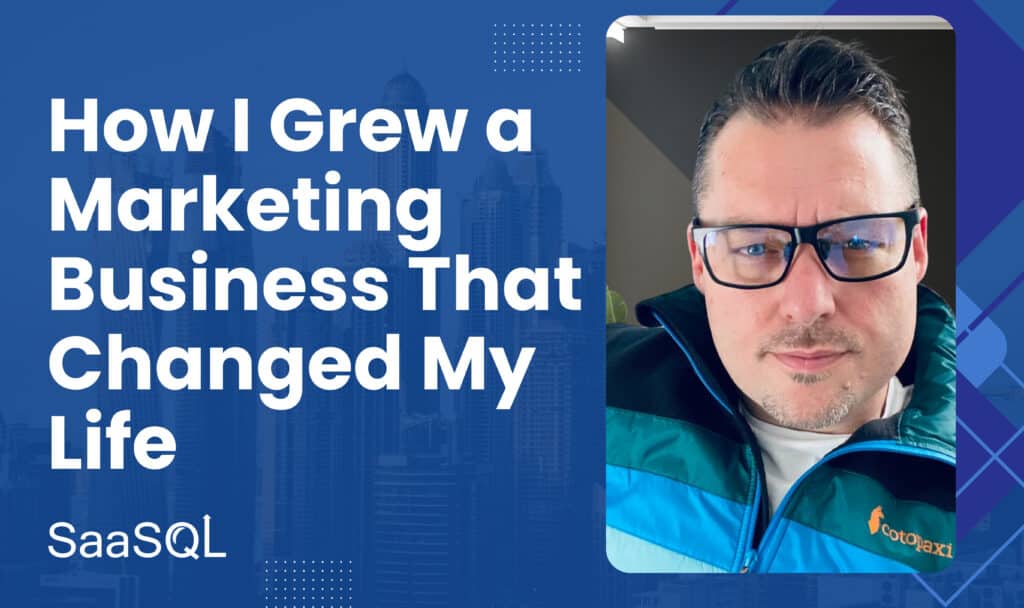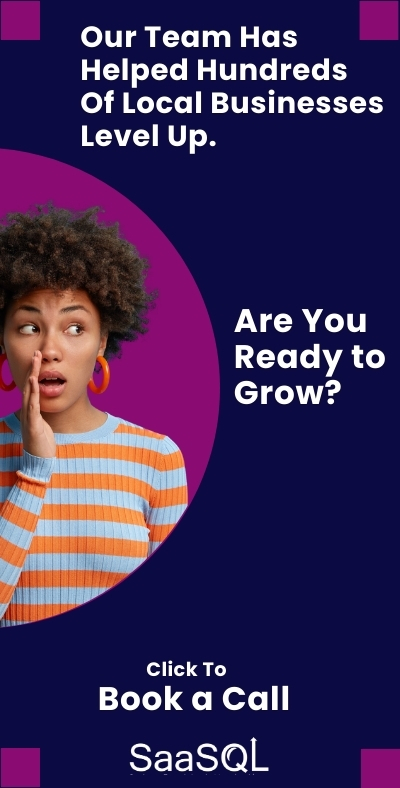If I could go back to the beginning, to the moment I first contemplated how to grow a marketing business, I wouldn’t read more books or watch more webinars. I would spend less time studying the competition. I wouldn’t even really worry about what services to offer.
If I could start over, I’d shift my entire focus to building momentum.

Because momentum solves almost everything. It silences the inevitable self-doubt. It attracts clients and builds proof. It keeps you moving forward, even when your inbox is empty and no one’s calling you back.
The mistake I made, and the one I see new agency owners make all the time, is treating that first client like its a trophy. I was just as guilty of chasing it. Held onto it too tightly and definitely let it define too much.
Looking back, I’d trade the thrill of that first “yes” for a process that consistently creates more of them. In other words, I’d invest less in the outcome and more in the steps that led me there.
It’s not about landing a whale. It’s about building a rhythm that works even when you’re tired and frustrated, distracted, or doubting your decisions.
Ultimately, that’s how you end up growing a marketing agency. It’s not with a breakthrough moment, but a series of clear steps that create a type of repeatable motion.
I know that sounds a bit vague and theoretical, but we’ll get concrete, shortly.
The First Sale Isn’t the Goal. Momentum Is.
Getting your first client feels like the milestone that validates everything. A milestone it is, validation – it shouldn’t be. If I could undo anything during those early days, it would be the way I obsessed over that first, and each subsequent individual “win.”
Instead of building a system, I chased deals. I sometimes said yes to projects that didn’t fit. I was willing to shape my pricing around whatever the client wanted. And when it was over, I was right back where I started, shaping and shaping and shaping.
What I needed wasn’t validation. I needed a strategic plan and the recognition that not all clients were meant to be my client. And that’s a good thing.
The truth is, one client means nothing if it doesn’t lead to the next one, or if it doesn’t support the type of business you want to run. You don’t grow a marketing agency by saying “yes”. You grow it by crafting simple and repeatable steps that create outcomes, even when you’re not feeling inspired.
So what does that look like, practically?
If I were starting today, I’d build a simple, sustainable system around four things:
- Daily Outreach – Ten high-quality messages a day. Not spam. Personalized, relevant, and brief. Use AI to speed things up: Clay, Instantly, ChatGPT. These tools make it incredibly efficient to develop thoughtful outlines, improve a tough paragraph and wrap up a stubborn thought.
- Weekly Networking – One event a week. Could be local, virtual, niche-based—whatever. The goal isn’t to sell, it’s to be visible. To talk. To be known. Relationships scale slower, but they stick.
- Monthly Content – One piece of content every month that showcases how you think. A case study. A teardown. A short video explaining something useful. Not polished. Just honest. Syndicate the content wherever you can. LinkedIn, Medium, your social channels.
- Social Engagement – Every day, spend 15–20 minutes engaging with the content of people you want to work with. Not just likes—leave thoughtful comments, share posts with a takeaway, ask a smart question. Show up where they are, give value, then earn the right to reach out. Warm familiarity always outperforms cold pitch volume.
Each piece feeds the next. Conversations from networking give you content ideas. Content builds credibility for outreach. Outreach generates calls. Calls create clients.
And if you don’t have case studies yet? Go earn them. Offer small, free “gateway” projects for a business you respect. It’s a simple process: make it good, turn it into a story, get a quote, ask for a referral. The work ultimately pays for itself in proof.
It doesn’t take a guru or a huge budget. It just takes a system that runs—even when you don’t feel like running it.
I’d log every conversation. I’d track what works, and I’d stop treating sales like an event, but a series of consistent habits.
Momentum makes the rest easier. It gives you leverage when negotiating. It sharpens your offer, creates referrals. It turns luck into math.
I Wouldn’t Call Myself an Agency. At Least Not Right Away
Early on, I thought calling myself an agency made me sound legitimate. Bigger, safer, like a real business. But it also made prospects expect more than I could deliver. More staff. More complexity. More overhead.
I positioned myself like a team. But I was solo. And that disconnect created friction I didn’t need.
If I were starting again, I’d lean into the truth. I’d say, “I’m an expert.” I’d show the work. I’d build credibility through clarity, not illusion.
The word “agency” implies structure. Departments. Account managers. Layers. But when you’re just getting started, none of that exists. So don’t pretend it does.
I’d present myself as a specialist with a system. Not a generalist with a logo.
The reality is, most clients don’t care if you’re an agency or not. They care if you can solve their problem, quickly and affordably and with consistency.
So if you’re small, be small be “boutique”- sharp and focused. Own your role. People trust experts more than they trust logos. Equally important, in a global business environment, your ideal customers are likely in your neighborhood, looking for a partner they can connect with and rely on, not a huge a agency 3,000 miles away.
I’d Choose One Market, One Offer, and Go Deep
When I started, I thought being full-service made me more valuable. “We do it all” felt like a strength. It wasn’t. It made everything harder.
More services meant more proposals, more learning curves, more tools, more confusion. It stretched my time thin and watered down my pitch. Worse, it made me sound just like everyone else.
If I could go back, I’d pick a niche. Not just an industry, but a problem I could solve completely. I’d focus on the one thing I could deliver better and faster than anyone else.
One clear outcome. One simple offer. One page on the site.
It sounds limiting, but it’s the opposite. It creates clarity. It gives you a story to tell. It gives your leads a reason to remember you.
Clients don’t want options. They want answers.
When you’re known for one thing, referrals become automatic. Your marketing gets easier. And ironically, once you’re seen as an expert in one lane, people start asking you to do more—on your terms.
Depth beats range. Every time.
Unsure about which problem to solve? Ask. Make it part of your social engagement habit. Reach out to business owners, ask them which problems they’re trying to solve. What’s stopping them from growing. Use those insights to inform your approach and specific area of expertise. Pro tip: when you do this, you’ll also acquire awesome insights for your monthly content.
I’d Automate First, Hire Later
The moment I started getting traction, I assumed it was time to hire. An assistant, a media buyer, a copywriter. I thought the answer to more work was more people.
It wasn’t. It was better systems.
A thing you’ll figure out soon enough: people are always the hardest part.
Hiring too soon created complexity. Managing people before I had clear processes slowed everything down. I spent more time training than doing. More time fixing mistakes than shipping results.
If I were starting over, I’d flip that completely. I’d let automation carry the weight before bringing on a team.
Today, there are AI tools that can handle (literally) (seriously) 80% of the heavy lifting:
- ChatGPT for first-draft copy, email sequences, FAQs, and content ideas
- SurferSEO or Frase for optimized content briefs and article structuring
- Zapier or Make for connecting apps and automating workflows
- Clay for intelligent prospecting and lead scoring
- Notion AI for organizing ideas, summarizing content, and writing outlines
- SaaSQL to manage contacts and outreach (even A.I. agents), while also providing services and solutions you can sell to clients
I’d build templates for everything. Outreach emails, onboarding documents, project timelines, proposal decks.
I’d set up workflows that trigger automatically: send a proposal when a call is booked, fire a welcome email when someone signs a deal, notify me when a lead revisits the site, or reads some of that content I’ve been producing.
And if a task still feels manual after all that? I’d question whether it even needs to be done. Surprising fact: most stuff we do doesn’t need to be done. The more important it “feels” the more you should question it.
That’s the new model. Tools first. Team second.
Because when you automate well, you don’t just save time. You save your margins. You protect your focus. And you create space to grow without breaking under the weight of your own success.
I’d Sell Like a Builder, Not a Closer
I used to think I had to become someone else to sell. More aggressive. More polished. Like the people on stage at sales conferences.
But every time I tried to “close,” I sounded like a copy of a copy. The confidence wasn’t real. The pitch didn’t land.
What worked? Building in public. Showing my work. But most importantly, sharing how I think. How I approach the problem of business growth. How I approach the problem of rising marketing costs and decreasing results.
How I think about my local community and the best ways to support it through my unique expertise.
When I stopped selling and started solving problems visibly, consistently, and with zero pressure, selling became much easier. And while I’m not suggesting this will happen overnight, believe me, eventually people will begin coming to you. In the meantime, you’ll position yourself to “sell” without ever really “selling”.
Here’s what I’d do if I were starting from scratch:
- Document my process. Turn what I do into simple visuals or walkthroughs.
- Answer common client questions in short videos or posts.
- Share behind-the-scenes of how I work: my tools, my checklists, my thinking.
- Create a feature for a business you think is killing it. Write about them, talk about them, tag them.
When people see how you work, they start to trust you. When they trust you, they don’t need to be sold.
Every time I did this, it generated a DM, a comment, a conversation. Not because I had a “hook” but because I made it easy to say, “That’s exactly what I need.”
That’s how you sell like a builder. You lay a public foundation and let the work speak for itself, eventually. And when the time comes, you literally never pitch a thing. You just listen to what the client needs and provide your best thinking. In other words, you’re a partner in the best sense.
I’d Spend Less Time on Vision, More Time on Velocity
I used to think I needed a five-year plan. A grand vision. The perfect roadmap before making a move.
But the truth is, I was just stalling. Planning was a safer way to feel productive without risking anything real.
What actually moved the needle? Doing the hard stuff, first.
Interestingly, the hard stuff was often the small stuff. Sending a single email to a prospect. Making a quick phone call. Tagging a local SMB. These are small things, but they require real effort, so we put them off. We put them off while we think “BIG”.
The anser is to do the small things, but do them quickly. Testing ideas without overthinking them. Shipping instead of strategizing.
Velocity beats vision.
If I were starting over, I’d focus on speed:
- Send the outreach email before the deck is perfect
- Launch the service before the website is done
- Post the insight before you’re sure it’s smart enough
Most of what you think you need to plan for will change once you take the first step. The market teaches faster than any brainstorm session ever will.
That doesn’t mean being reckless. It means working in short cycles. Week by week. Input, feedback, adjustment. Again and again.
The faster you move, the faster you learn. And the faster you learn, the better your direction becomes.
You don’t grow a marketing agency with a crystal ball. You grow it with momentum. One imperfect action at a time.
Closing Thought: Growth Is Just What You Do After You Stop Pretending
When I look back, most of my mistakes came from pretending or emulating some version of what I thought I “should” be.
Pretending I was bigger than I was. Smarter than I felt. Ready for things I hadn’t earned. Perhaps, caring too much about what other people thought.
I did things I really didn’t need to do. I took clients I couldn’t serve well, or who frankly, I didn’t like very much. Said yes when I should have said, “we’re not the right fit”.
Growth started when I dropped the act and decided, this is who I am, and this is what I know I can do well. These are the problems I can solve.
When I admitted what I didn’t know. When I stopped trying to impress and started trying to improve, giving myself permission to build a business that actually fit me – not some ideal I thought people expected – that’s when momentum began.
The moment you stop pretending, you can finally start solving. And the faster you solve problems, the faster you grow.
Not every day will feel like progress. In fact, if you’re just getting started, nearly every day will feel like a waste of time. Believe me. But what makes you an entrepreneur is your willingness to feel that frustration, and keep on going anyway. Keep listening, building and adjusting. You won’t know it at the time, but you’ll already be ahead of most.
Do that, and trust me, it’ll work out in the end.
Ultimately, there’s no secret formula to this gig. As with most efforts, it just comes down to honest work that you do over and over again. Of course, backed by tools that multiply your time.
That’s how you grow a marketing business – that’s how I grew a marketing business that changed my life. And that’s exactly what I’d do if I were starting over today.
QL Group: Okay, now, if you’re a marketer who wants to start or scale a marketing agency and you’d like a partner in success, you might find QL Group is just what you’re looking for. QL Group is not a course I sell or any such nonsense. It’s me and you, working together to build a brand. If that sounds interesting, visit the page and learn a bit more.
How to Grow a Marketing Business – Frequently Asked Questions
1. What’s the best way to get clients when starting a marketing agency?
Focus on building momentum, not just landing one big client. Use daily outreach, weekly networking, consistent content, and active social engagement to create a repeatable system that generates conversations and opportunities.
2. Do I need to hire a team right away to grow my agency?
No. Start by leveraging AI tools and automation to handle repetitive tasks. This keeps you lean, efficient, and focused. Hire only when the demand consistently exceeds your solo capacity and you have clear processes in place.
3. Should I offer a wide range of services at first?
Stick to one offer, one problem, one market. Clarity makes it easier to attract the right clients and build authority. Expanding services too soon can dilute your focus and make everything harder to manage.
4. How can I sell my services without feeling pushy or fake?
Document your process. Share insights. Be visible. When you build in public and show how you think, you earn trust—and that trust generates inbound interest. Focus on solving problems, not closing deals.
5. How important is planning versus just taking action?
Planning has its place, but too much of it can slow you down. Action leads to real feedback. Build fast, learn faster. Small experiments will give you more clarity than long-term speculation.




